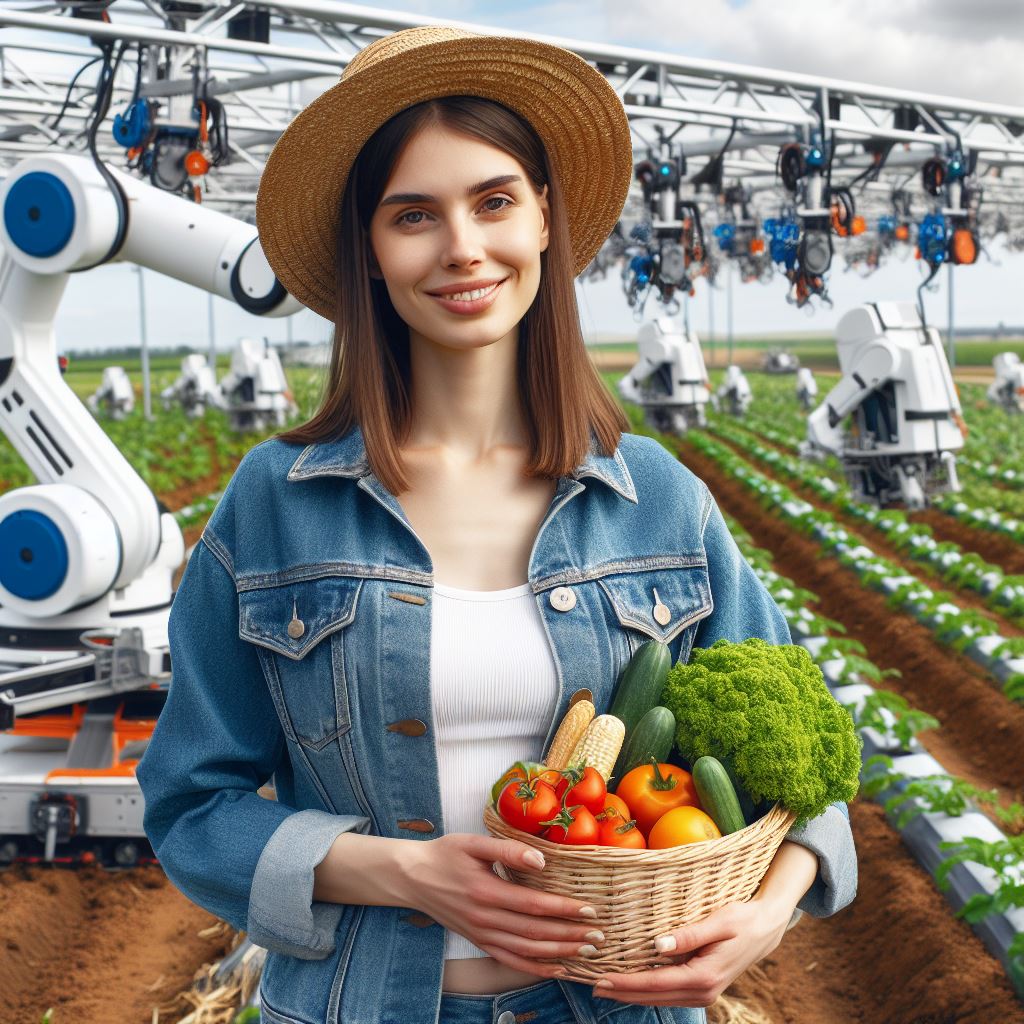Introduction
Conventional to organic farmer path
In the world of farming, there is a growing movement towards transitioning from conventional to organic methods.
This shift has gained significant importance in recent years as consumers become more conscious of the impact of traditional farming practices on their health and the environment.
Understanding the journey of a farmer who decides to make this switch is crucial in appreciating the challenges and benefits associated with organic farming.
Organic farming is a method that focuses on utilizing natural processes and materials to maintain and improve soil fertility, prevent pests and diseases, and promote healthy crops.
It eliminates the use of synthetic chemicals such as fertilizers, pesticides, and antibiotics.
This paradigm shift towards organic farming reflects the need to adopt sustainable practices that prioritize soil health, biodiversity, and long-term environmental sustainability.
For a farmer, transitioning from conventional to organic farming is not an easy task.
It requires a deep understanding of the complexities associated with organic certification, the implementation of new farming techniques, and the potential financial risks involved.
Farmers need to gain knowledge about organic principles, learn about soil management, and adjust their farming practices accordingly.
Moreover, they may need to invest in different equipment and modify their marketing strategies to tap into the organic market.
The decision to switch from conventional to organic farming represents a significant commitment from farmers to produce food in an environmentally friendly and sustainable manner.
By understanding the farmer’s journey towards organic farming, we can gain insights into the challenges they face and the steps necessary to support this transition.
In the following sections, we will explore the various aspects of this journey, including the initial motivations, the obstacles encountered, and the rewards reaped from embracing organic farming practices.
Background on conventional farming
The practices and techniques involved in conventional farming
Conventional farming has long been the dominant agricultural system globally.
Its practices and techniques aim to maximize crop production and ensure food supply in a rapidly growing world population.
However, these conventional methods come with a range of potential drawbacks and negative impacts that raise concerns for both the environment and human health.
One of the main practices involved in conventional farming is the use of synthetic pesticides and fertilizers.
These chemicals are used extensively to control pests, diseases, and weeds, as well as to enhance crop yields.
While they may appear effective in the short term, their long-term effects on the environment can be detrimental.
Pesticide runoff can contaminate water sources, harming aquatic life and posing risks to human health.
In addition to chemical inputs, conventional farming heavily relies on genetically modified organisms (GMOs).
These genetically engineered crops are designed to withstand pests, diseases, and herbicides, allowing for increased productivity.
However, concerns arise regarding the potential long-term effects of GMOs on ecosystems and human health.
The limited biodiversity resulting from mono-cropping is another significant concern linked to conventional farming, as it disrupts natural ecological relationships.
Potential drawbacks and negative impacts associated with conventional farming
The extensive use of machinery in conventional farming contributes to the consumption of fossil fuels and greenhouse gas emissions.
This dependence on non-renewable energy resources exacerbates climate change and further threatens environmental sustainability.
Moreover, frequent soil tilling, a common practice in conventional farming, leads to soil erosion, nutrient depletion, and reduced soil fertility.
This degradation of soil health ultimately affects crop productivity and long-term sustainability.
Apart from the environmental impacts, conventional farming poses risks to the well-being of farmers and consumers.
Exposure to pesticides and other chemicals used in conventional farming can result in health problems, including acute poisoning and chronic illnesses.
Consumers, too, may be susceptible to the adverse effects of pesticide residues on food.
Furthermore, the overuse of pesticides and herbicides can lead to the emergence of resistant pests and weeds, creating a never-ending cycle of chemical dependency.
The socioeconomic implications of conventional farming should also be considered.
Small-scale farmers often struggle to compete with larger industrial farms that have greater access to machinery, technology, and market influence.
This inequality contributes to the decline of small-scale farming and rural communities, leading to economic and social imbalances.
In fact, conventional farming practices have been widely adopted for their ability to produce large quantities of food.
However, the negative impacts associated with these practices cannot be ignored.
From environmental degradation and health risks to economic inequalities, conventional farming raises serious concerns.
As such, alternative and sustainable approaches like organic farming have gained popularity, offering a path forward towards a more balanced and resilient agricultural system.
Read: Organic Trials: One Farmer’s Shift Story
Reasons for transitioning to organic farming
Shift towards sustainable and environmentally friendly practices
- Farmers are transitioning to organic farming due to its sustainable and environmentally-friendly practices.
- Organic farming focuses on preserving soil health and minimizing water pollution.
- Practices such as crop rotation and cover cropping help replenish soil nutrients naturally.
- By avoiding synthetic inputs, organic farming promotes a healthier ecosystem and biodiversity.
- The shift towards organic farming contributes to the conservation of natural resources and reduces pollution.
- Organic farmers prioritize the use of renewable resources and minimize their carbon footprint.
Health concerns related to pesticides and synthetic fertilizers
- Pesticides and synthetic fertilizers used in conventional farming pose risks to human health.
- These inputs are known to contaminate water sources, affecting both human and animal consumption.
- Prolonged exposure to pesticides has been linked to various health issues, including cancer.
- Organic farming eliminates the use of harmful pesticides and synthetic fertilizers, ensuring safer food production.
- The absence of chemical residues in organic food reduces health risks for consumers.
- By choosing organic farming, farmers prioritize the health and well-being of their customers.
The growing demand for organic food in the market
- The demand for organic food has been steadily increasing in recent years.
- Consumers are becoming more conscious about their food choices and the impact on their health.
- Organic food is perceived as healthier, tastier, and free from harmful chemicals.
- People are willing to pay a premium price for organic food due to its perceived benefits.
- The organic market offers great opportunities for farmers to meet the growing demand.
- Transitioning to organic farming allows farmers to tap into this lucrative market and increase their profitability.
Generally, the transition to organic farming is driven by various reasons.
Farmers choose organic practices to align with sustainable and environmentally-friendly principles.
They aim to reduce pollution, conserve natural resources, and promote biodiversity.
Moreover, the health concerns related to pesticides and synthetic fertilizers push farmers towards organic farming.
By eliminating harmful chemicals, they provide safer food options for consumers.
Additionally, the growing demand for organic food in the market presents an economic opportunity for farmers.
By transitioning to organic farming, they can meet the increasing demand and enhance their profitability.
Overall, the shift towards organic farming benefits both the environment and human health.
Read: Climate Change: An Alaskan Farmer’s Fight
Transform Your Agribusiness
Unlock your farm's potential with expert advice tailored to your needs. Get actionable steps that drive real results.
Get StartedChallenges faced during the transition
Difficulties in eliminating chemical inputs and implementing organic practices
- Resistance to change: Farmers may be resistant to eliminate chemical inputs due to familiarity and convenience.
- Limited knowledge: Lack of understanding about organic practices and their benefits can hinder transition.
- Pest and weed control: Organic methods may require more labor-intensive and complex approaches for pest and weed control.
- Soil fertility management: Organic farmers need to focus on composting, cover cropping, and crop rotation to maintain soil fertility.
- Transition period: Eliminating chemical inputs and implementing organic practices takes time to show results.
Potential financial implications and costs associated with the switch
- Initial investment: Transitioning to organic farming often requires new equipment, infrastructure, and training, which can be costly.
- Reduced yields: Organic farming may initially result in lower yields, affecting the income of farmers.
- Marketing and certification costs: Organic certification requires fees and additional expenses for complying with labeling and marketing standards.
- Price premiums: While organic products may command higher prices, farmers need to meet the strict organic standards to receive these premiums.
- Market uncertainty: Organic farming is subject to market fluctuations and demand, which can impact profitability.
Time and effort required to obtain organic certification
- Understanding requirements: Farmers need to educate themselves about the strict guidelines and regulations for organic certification.
- Record-keeping: Detailed records of farming practices, inputs, and compliance are necessary for the certification process.
- Inspection and evaluation: External certifying agencies conduct thorough inspections to ensure compliance with organic standards.
- Time commitment: The certification process can take several years, including a period for transitioning and maintaining organic practices.
- Ongoing compliance: Organic farmers must continuously adhere to the standards to maintain their certification, requiring consistent effort.
Read: Pest Plight: Stories from the Field

Uncover the Details: Vertical Farming: A High-Rise Harvest
You Might Also Like: Farming Futures: Young Voices in Agriculture
Steps taken during the transition
Farmer’s specific approach in shifting towards organic practices
Switching from conventional to organic farming requires careful planning and execution.
The farmer, John, followed a well-thought-out approach to ensure a successful transition.
These steps included:
1. Research and education
John extensively studied organic farming practices, attending workshops, and reading scientific literature.
He sought advice from experienced organic farmers to gain insights into the best techniques to implement.
2. Soil assessment and improvement
One of the first steps John took was to assess the health of his soil.
He collected soil samples and sent them to a laboratory for analysis.
Based on the results, he made amendments to improve the soil’s fertility and structure, such as adding compost and organic matter.
3. Crop rotation
Implementing crop rotation was vital in maintaining soil health and preventing pest and disease buildup.
John carefully planned a crop rotation schedule, ensuring a diverse range of crops and incorporating nitrogen-fixing plants to enhance soil fertility.
4. Integration of livestock
John introduced livestock, such as chickens and goats, into his farming system.
Their manure provided valuable organic fertilizer, and their presence helped control pests naturally.
Livestock also contributed to soil fertility through their grazing and dung activities.
5. Pest control methods
To replace chemical pesticides, John adopted alternative pest control methods.
He encouraged natural predators by planting companion crops and creating habitats for beneficial insects.
He also utilized physical barriers, such as nets and traps, to prevent pest damage.
6. Organic fertilizers
Instead of synthetic fertilizers, John incorporated organic fertilizers into his farming practices.
He utilized compost, animal manure, and cover crops to meet the nutritional needs of his plants.
These organic fertilizers not only improved soil health but also minimized nutrient runoff.
Implementation of alternative pest control methods, organic fertilizers, etc.
During his transition to organic farming, John eliminated the use of chemical pesticides and synthetic fertilizers.
He embraced alternative pest control methods and organic fertilizers to ensure sustainable and eco-friendly agricultural practices.
1. Alternative pest control methods
John employed several strategies to control pests without using chemical pesticides.
He practiced integrated pest management (IPM), which involved monitoring pest populations, creating habitat diversification, and promoting natural predators.
This approach reduced the dependency on pesticides and allowed the ecosystem to maintain its balance.
2. Organic fertilizers
To nourish his crops, John relied on organic sources of nutrients.
Compost, made from decomposed plant material, crop residues, and livestock manure, was a key component of his organic fertilization program.
He also used cover crops, such as legumes and grasses, to improve soil fertility through nitrogen fixation and organic matter addition.
3. Compost tea and natural sprays
As an additional boost for plant health, John brewed compost tea, a liquid fertilizer created by steeping compost in water.
This nutrient-rich tea was applied to crops as a foliar spray or drenched into the soil.
He also made natural sprays using ingredients like neem oil, garlic, and chili to control specific pests and diseases.
Training or educational resources utilized during the transition
John understood the importance of acquiring knowledge and skills before transitioning to organic farming.
He took advantage of various training and educational resources to enhance his understanding of organic practices and gain practical insights.
1. Organic farming workshops
John attended workshops organized by local organic farming associations and agricultural institutes.
These workshops covered a wide range of topics, including soil health, composting techniques, crop rotation, and pest control methods.
The interaction with experienced farmers was invaluable in building his knowledge base.
2. Online resources and forums
The internet played a crucial role in John’s learning process.
He explored online resources, such as blogs and websites dedicated to organic farming, to access articles, expert advice, and case studies.
He also participated in online forums, where he could seek guidance from experienced organic farmers and engage in discussions.
3. Mentoring and networking
To further his understanding, John sought mentorship from established organic farmers in his region.
These mentors provided him with guidance, shared their practical experiences, and connected him with other organic farmers.
Networking with like-minded individuals enabled John to learn from their successes and challenges.
In essence, transitioning from conventional to organic farming requires a well-planned approach and a willingness to learn and adapt.
John meticulously followed steps such as research and education, soil assessment and improvement, implementing crop rotation, integrating livestock, and utilizing alternative pest control methods and organic fertilizers.
He actively sought knowledge through workshops, online resources, and mentorship.
Through his dedication, John successfully shifted towards organic practices, embracing sustainability and environmental stewardship in his farming journey.
Read: Water Scarcity: A California Farmer’s Story
Benefits of Organic Farming
Organic farming positively impacts soil health and biodiversity.
- Organic farming practices promote the use of natural fertilizers, such as compost and manure, which enrich the soil with essential nutrients.
- By avoiding the use of synthetic pesticides and herbicides, organic farming preserves the natural balance of beneficial insects and microorganisms in the soil.
- Organic farmers also prioritize crop rotation and intercropping, which contribute to healthier soil structure and fertility.
Organic products offer potential marketing advantages and the ability to command premium prices.
- Increasing consumer awareness and demand for organic products creates a lucrative market for farmers.
- The organic label signifies that the product is free from pesticides, genetically modified organisms (GMOs), and synthetic additives, attracting health-conscious consumers.
- Organic farmers can tap into niche markets, such as organic fruits and vegetables or organic dairy products, further enhancing their marketing advantage.
- Premium prices for organic products can compensate for the higher production costs associated with organic farming practices.
The farmer experiences overall satisfaction and fulfillment through practicing organic farming.
- Organic farmers often find a deeper connection with the land and nature through their sustainable practices.
- The knowledge that their farming methods are nurturing the earth and preserving its resources brings a sense of purpose and satisfaction.
- Organic farming allows farmers to produce food in harmony with the environment, aligning with their personal values and ethical beliefs.
- The positive feedback and appreciation they receive from consumers who value organic products also contribute to their fulfillment.
In short, organic farming offers numerous benefits, including positive impacts on soil health and biodiversity, potential marketing advantages, and the personal satisfaction experienced by farmers.
By prioritizing sustainable practices and avoiding the use of synthetic inputs, organic farmers contribute to the long-term health of the soil, protect biodiversity, and satisfy consumer demand for safe and environmentally friendly products.
Moreover, the ability to command premium prices allows organic farmers to compensate for the higher production costs involved.
For these reasons, transitioning from conventional to organic farming can be a fulfilling and profitable path for farmers seeking a sustainable and rewarding agricultural practice.
Conclusion
The farmer’s journey from conventional to organic farming signifies a commitment to sustainability.
Supporting organic agriculture is paramount for a healthier planet. Explore organic farming to understand its significance.
Transitioning from conventional methods to organic practices enhances soil health and biodiversity.
By supporting organic farming, we safeguard ecosystems and wildlife habitats. Every purchase empowers farmers dedicated to ethical cultivation.
Embrace organic produce for its superior taste and nutritional value. It’s a vote for sustainable farming practices.
Let’s prioritize farms that prioritize the environment. Support initiatives that promote organic farming.
Showcase Your Farming Business
Publish your professional farming services profile on our blog for a one-time fee of $200 and reach a dedicated audience of farmers and agribusiness owners.
Publish Your ProfileIn a nutshell, the farmer’s path from conventional to organic is a testament to resilience.
Embrace organic farming as a solution to environmental degradation.
Together, let’s cultivate a world where organic agriculture thrives.




